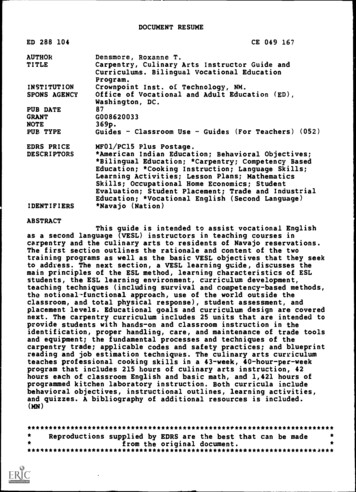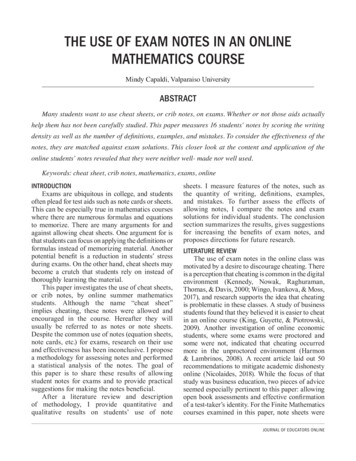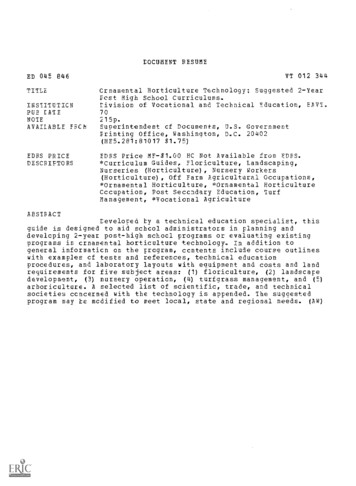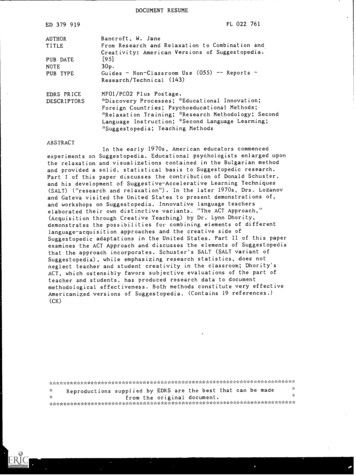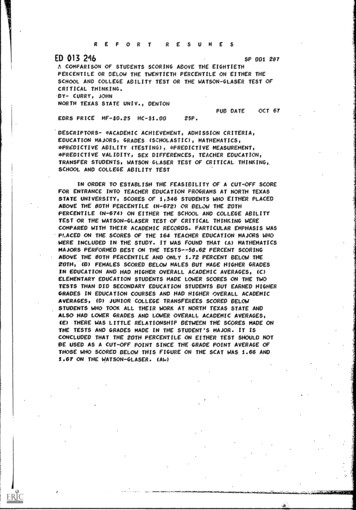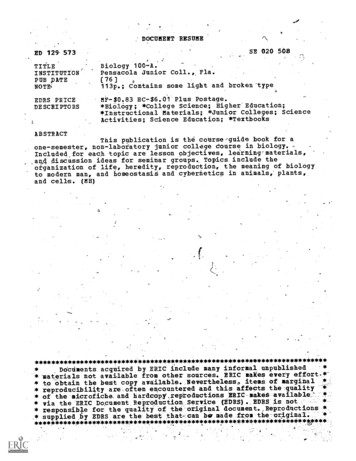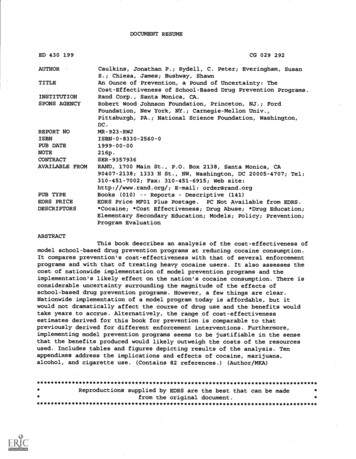
Transcription
DOCUMENT RESUMEED 430 199AUTHORTITLEINSTITUTIONSPONS AGENCYCG 029 292Caulkins, Jonathan P.; Rydell, C. Peter; Everingham, SusanS.; Chiesa, James; Bushway, ShawnAn Ounce of Prevention, a Pound of Uncertainty: TheCost-Effectiveness of School-Based Drug Prevention Programs.Rand Corp., Santa Monica, CA.Robert Wood Johnson Foundation, Princeton, NJ.; FordFoundation, New York, NY.; Carnegie-Mellon Univ.,Pittsburgh, PA.; National Science Foundation, Washington,DC.REPORT NOISBNPUB DATENOTECONTRACTAVAILABLE FROMPUB TYPEEDRS 0-00216p.SER-9357936RAND, 1700 Main St., P.O. Box 2138, Santa Monica, CA90407-2138; 1333 H St., NW, Washington, DC 20005-4707; Tel:310-451-7002; Fax: 310-451-6915; Web site:http://www.rand.org/; E-mail: order@rand.orgBooks (010) -- ReportsDescriptive (141)EDRS Price MF01 Plus Postage. PC Not Available from EDRS.*Cocaine; *Cost Effectiveness; Drug Abuse; *Drug Education;Elementary Secondary Education; Models; Policy; Prevention;Program EvaluationABSTRACTThis book describes an analysis of the cost-effectiveness ofmodel school-based drug prevention programs at reducing cocaine consumption.It compares prevention's cost-effectiveness with that of several enforcementprograms and with that of treating heavy cocaine users. It also assesses thecost of nationwide implementation of model prevention programs and theimplementation's likely effect on the nation's cocaine consumption. There isconsiderable uncertainty surrounding the magnitude of the effects ofschool-based drug prevention programs. However, a few things are clear.Nationwide implementation of a model program today is affordable, but itwould not dramatically affect the course of drug use and the benefits wouldtake years to accrue. Alternatively, the range of cost-effectivenessestimates derived for this book for prevention is comparable to thatpreviously derived for different enforcement interventions. Furthermore,implementing model prevention programs seems to be justifiable in the sensethat the benefits produced would likely outweigh the costs of the resourcesused. Includes tables and figures depicting results of the analysis. Tenappendixes address the implications and effects of cocaine, marijuana,alcohol, and cigarette use. (Contains 82 references.) tions supplied by EDRS are the best that can be madefrom the original ***************************************
C6IIIII;a11/IIPERMISSION TO REPRODUCE ANDDISSEMINATE THIS MATERIAL IN MICROFICHE,U S DEPARTMENT OF EDUCATIONOffice of Educational Research and ImprovementAND IN ELECTRONIC MEDIA FOR ERICCOLLECTION SUBSCRIBERS ONLY,HAS BEEN GRANTED BYEDUCATIONAL RESOURCES INFORMATIONCENTER (ERIC)fl This document has been reproduced asreceived from the person or organizationPPN\c\originating it11 Minor changes have been made to improvereproduction qualityPoints of view or opinions stated in this docu2Ament do not necessarily represent officialOERI position or policy2TO THE EDUCATIONAL RESOURCESINFORMATION CENTER (ERIC)IIEST On AVM LA LE
An Ounce ofPreventionA Pound ofUncertainty3
An Ounce ofPreventionA Pound ofUncertaintyThe Cost-Effectivenessof School-BasedDrug Prevention ProgramsJonathan P. Caulkins, C. Peter Rydell,Susan S. Everingham, James Chiesa, Shawn BushwayDRUG POLICY RESEARCH CENTERRAND
The research described in this report was supported by The Robert Wood JohnsonFoundation's Substance Abuse Policy Research Program and by the National ScienceFoundation under Grant No. SER-9357936. Additional support was provided byCarnegie Mellon University and by RAND's Drug Policy Research Center with fundingfrom the Ford Foundation.Library of Congress Cataloging-in-Publication DataAn ounce of prevention, a pound of uncettainty : the cost-effectiveness ofschool-based drug prevention programs /Jonathan P. Caulkins . [et al.).cm.P.MR-923-RWLIncludes bibliographical references.ISBN 0-8330-2560-01. YouthDrug useUnited StatesPreventionCost effectiveness2. StudentsDrug useUnited StatesPreventionCost effectiveness.3. Cocaine habitUnited StatesPreventionCost effectiveness.4. Drug abuse Study and teachingUnited StatesCost effectiveness.I. Caulkins, Jonathan P. (Jonathan Paul) , 1965HV5824.Y680941999362.09 ' 17 ' 0973dc2199-19931C1PRAND is a nonprofit institution that helps improve policy and decisionmakingthrough research and analysis. RAND is a registered trademark. RAND's publicationsdo not necessarily reflect the opinions or policies of its research sponsors.Cover design by Eileen Delson La Russo0 Copyright 1999 RANDAll rights reserved. No part of this book may be reproduced in any form by any electonic or mechanical means (including photocopying, recording, or information storage and retrieval) without permission in writing from RAND.Published 1999 by RAND1700 Main Street, P.O. Box 2138, Santa Monica, CA 90407-21381333 H St., N.W, Washington, D.C. 20005-4707RAND URL: http://wwwsand.org/To order RAND documents or to obtain additional information,contact Distribution Services: Telephone: (310) 451-7002;Fax: (310) 451-6915; Internet: order@rand.org5
In memory of Peter Ryden,friend and modeler extraordinaire
PREFACEThis book describes an analysis of the cost-effectiveness of modelschool-based drug prevention programs at reducing cocaine consumption. We compare prevention's cost-effectiveness with that ofseveral enforcement programs and with that of treating heavy cocaine users. We also assess the cost of nationwide implementation ofmodel prevention programs and the implementation's likely effecton the nation's cocaine consumption.There is considerable uncertainty surrounding the cost-effectivenessof school-based drug prevention programseven the model programs to which we restrict the scope of this study. Hence we providea range of cost-effectiveness estimates. The range is comparable tothat previously derived for different enforcement interventions. Nationwide implementation of a model program would be affordable,but it would not dramatically affect the course of drug use, and alsothe benefits would take years to accrue. Nevertheless, implementingmodel prevention programs seems to be justifiable in that the benefits produced would likely outweigh the costs of the resources used.This is the latest in a series of publications by RAND's Drug PolicyResearch Center that addresses the cost-effectiveness of drug controlstrategies. The other available volumes are as follows:Susan S. Everingham and C. Peter Rydell, Modeling the Demandfor Cocaine, MR-332-ONDCP/A/DPRC, 1994.C. Peter Rydell and Susan S. Everingham, Controlling Cocaine:Supply Versus Demand Programs, MR-331-ONDCP/A/DPRC,1994.vii
viii An Ounce of Prevention, a Pound of UncertaintyJonathan P. Caulkins, C. Peter Rydell, William L. Schwabe, andJames Chiesa, Mandatory Minimum Drug Sentences: ThrowingAway the Key or the Taxpayers' Money? MR-827-DPRC, 1997.The research described in this book was sponsored by The RobertWood Johnson Foundation through its Substance Abuse Policy Research Program. The work was also funded in part by a grant fromthe National Science Foundation. Our opinions, findings, conclusions, and recommendations do not necessarily reflect the views ofour sponsors.RAND's Drug Policy Research Center examines drug use trends andassesses control strategies for various sponsors and draws on coresupport from The Ford Foundation to sustain drug-research-relateddatabases and to ensure broad dissemination of results.Additional support was provided by Carnegie Mellon University andby RAND's Drug Policy Research Center with funding from The FordFoundation.
CONTENTSPrefaceviiFiguresxiiiTablesxvSummaryxix hiAcknowledgmentsChapter OneINTRODUCTIONAn Analysis of Costs and EffectivenessBeyond Cost-EffectivenessAn Issue Not Yet ExaminedOur Focus12567Chapter TwoEFFECTIVENESS AT REDUCING COCAINECONSUMPTIONEffect on Cohort Members Participating in ProgramProportion of Cohort That Would Otherwise UseCocaineLifetime ConsumptionProgram EffectDiscount FactorSummaryMultipliersSocial MultiplierMarket MultiplierQualifiersix1112131517283131313435
xAn Ounce of Prevention, a Pound of UncertaintyIntegrating the FactorsUncertaintySources of Effect373942Chapter ThreeCOST-EFFECTIVENESS AT REDUCING COCAINECONSUMPTIONDefining Program CostEstimating Program CostEstimating Cost-Effectiveness and the Implications ofUncertaintyVariation With the Passage of Time4545495156Chapter FourOTHER BENEFITS59Estimating the Effect on Use of Drugs Other ThanCocaineSimple Program EffectivenessOther FactorsComparison of EffectsSocial Savings from Reduced Drug UseCocaineOther DrugsBenefits Unrelated to Reduced Drug Consumption5960646568697071Chapter FiveNATIONWIDE IMPLEMENTATIONImplications for the Current Cocaine EpidemicImplications for Future EpidemicsImplications for the Legalization Debate73747578Chapter SixCONCLUSIONS AND POLICY IMPLICATIONSModel Prevention Programs Appear to Be CompetitiveWith EnforcementGreat Uncertainty Remains About Prevention's CostEffectivenessThe Source of Benefits Is Not What Might Be Expected .Drug Use Prevention Has Benefits Other Than ReducedCocaine UseA National Program Is Affordable but Will Not End theCocaine Epidemic818182838484
ContentsDrug Prevention Should Be Conducted Before It IsPerceived NecessaryPrevention Cannot Substitute for Enforcement in aLegalization RegimeThe Bottom Linexi858686AppendixA. ESTIMATING AVERAGE LIFETIME COCAINECONSUMPTION89B. PREVENTION'S EFFECTIVENESS AT REDUCINGMARIJUANA INITIATION97C. RELATIONSHIP BETWEEN AGE OF MARIJUANAINITIATION AND LIFETIME CONSUMPTION OFCOCAINE AND MARIJUANA105D. ESTIMATING THE MAGNITUDE OF THE SOCIALMULTIPLIER115E. HOW PREVENTION'S COST-EFFECTIVENESS VARIESOVER TIME131F.ESTIMATING THE MAGNITUDE OF THE MARKETMULTIPLIER139G. ESTIMATING THE MAGNITUDE OF THECAUSATION/CORRELATION QUALIFIER143H. ESTIMATING THE MAGNITUDE OF THE SCALE-UPDEGRADATION QUALIFIER155I.J.PREVENTION'S EFFECT ON HEAVY ALCOHOL USE ANDCIGARETTE SMOKING163ACCUMULATION OF PREVENTION'S EFFECTNATIONWIDE177References185
.3.1.Factors Contributing to the Effectiveness ofPrevention at Redudng Cocaine ConsumptionReduction in Cohort's Cocaine Consumption forDifferent Assumed Values of Marijuana InitiationReduction and PermanenceComparison of Prevention With Other CocaineControl ProgramsFactors Contributing to the Effectiveness ofPrevention at Reducing Cocaine ConsumptionProportion of People in Cohorts Who ReportedHaving Ever Used CocaineLater Marijuana Initiation Is Associated With ReducedRisk of Ever Using CocaineLater Marijuana Initiation Is Associated With ReducedConsumption of Cocaine by Those Who Ever Use It . .Proportion of Cohort First Using Marijuana atDifferent AgesReduction in Cohort's Cocaine Consumption forDifferent Assumed Values of Marijuana InitiationReduction and PermanenceSources of Prevention-Induced Reduction in CocaineConsumption by Program ParticipantsContributions by Different Groups to TotalPrevention-Induced Reduction in CocaineConsumptionComparison of Prevention With Other CocaineControl Programs12xxixxiiixxix111420212627434353
xiv An Ounce of Prevention, a Pound of Uncertainty4.1. Reduction in Cohort's Marijuana Consumption forDifferent Assumed Values of Marijuana InitiationReduction and Permanence4.2. Reduction in Cohort's Alcohol Consumption forDifferent Assumed Values of Alcohol InitiationReduction and Permanence4.3. Reduction in Cohort's Cigarette Consumption forDifferent Assumed Values of Cigarette InitiationReduction and Permanence5.1. Prevention Will Only Modestly Reduce the Number ofCocaine Users over a Period of DecadesB.1. Proportion of Cohort First Using Marijuana atDifferent AgesB.2. Difference Between Percentage Initiating MarijuanaUse With and Without PreventionC.1. Sources of Prevention-Induced Reduction in CocaineConsumption by Program ParticipantsC.2. Reduction in Cohort's Cocaine Consumption forDifferent Assumed Values of Marijuana InitiationReduction and PermanenceC.3. Reduction in Cohort's Marijuana Consumption forDifferent Assumed Values of Marijuana InitiationReduction and PermanenceD.1. Modeled Initiation Compared With Initiation Datafrom the Substance Abuse and Mental Health ServicesAdministrationE.1. How Effective a Given Prevention Program WouldHave Been over Time, As the Nature of the EpidemicVariedJ.1. Prevention Will Only Modestly Reduce the Number ofCocaine Users over a Period of Decades61626476103103110111113124137182
TABLES1.1.Differences Between This Study and Previous Ones82.1. Alternative Estimates of Average Lifetime Cocaine2.2.2.3.2.4.3.1.ConsumptionFirst Four Factors of the Eight-Factor ModelEstimated Effect of Prevention on CocaineConsumption Per ParticipantProbability Distribution of Overall EffectivenessValues from Monte Carlo SimulationInstructional-Staff and Facilities Costs, U.S. K-121631Public Schools, 1992-93 School Year50503.2. Cost of Life Skills Training Program3.3. Cost-Effectiveness at Reducing w, Middle, and High Cost-Effectiveness Estimatesfor Different Cocaine Control StrategiesIllustration of Implications of Different OpinionsAbout Factors Related to Prevention'sCost-EffectivenessCalculating the Effects on Alcohol and Cigarette Useand Comparing Them With Cocaine and MarijuanaEstimatesBase Estimates and Ranges of Effect, Discounted andUndiscounted, for All Drugs ConsideredFinite-Horizon Lifetime Consumption Estimates fromthe Markov ModelAlternative Estimates of Average Lifetime CocaineConsumption555566679396xv14
xvi An Ounce of Prevention, a Pound of .7.1.8.1.9.Percentage Difference Between Program Recipientsand Controls for Various Measures of Drug Use
Robert Wood Johnson Foundation, Princeton, NJ.; Ford Foundation, New York, NY.; Carnegie-Mellon Univ., Pittsburgh, PA.; National Science Foundation, Washington, DC. MR-923-RWJ ISBN-0-8330-2560-0 1999-00-00. 216p. SER-9357936 RAND, 1700 Main St., P.O. Box 2138, Santa Monica, CA 90407-2138; 1333 H St., NW, Washington, DC 20005-4707; Tel:

